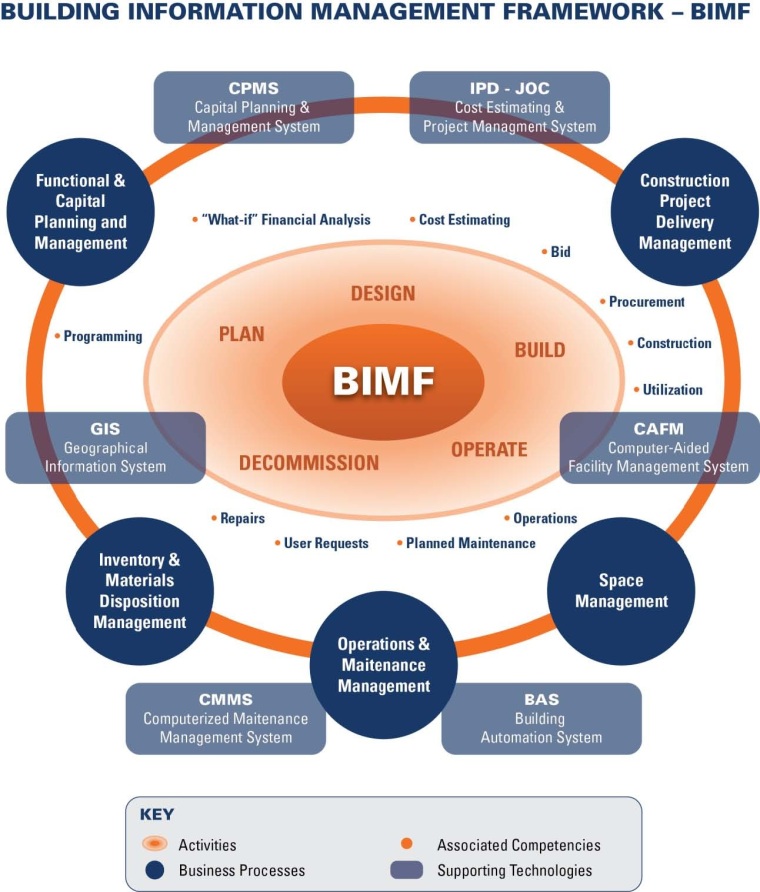Ok, so we get that 3D visualization is a component of BIM. Design concepts can be beautifully illustrated, and one can relatively easily make a change to the model and the output documents update. Clash detection and the ability to eliminate clashes prior to the construction work starting is also a big “plus” for BIM. Now it is time to focus on the information in BIM.
It’s time to focus on the true value of BIM for Owners (as well as Contractors, Oversight Groups, the general Community, etc.), the efficient life-cycle management of the built environment.
There are major challenges to attaining BIM, the most significant being change management. For example, the traditional culture of the AECOO sector (Architecture, Engineering, Construction, Operations, Owner) has been based upon adversarial, non-collaborative ways of conducting day to day business. As a result, sharing information, consistency, and standardized efficient practices have been difficult at best.
Cloud computing, as well as major market drivers may force change. That said, when information becomes more widespread, what standards will it be authored to? How are things and/or objects defined? How and when will information be updated? What specifics and/or parameters are required to define or redefined and object. For example take a door – physical configuration (accessibility, dimensions, weight, materials, manufacturer, year built/age), functional aspects(acoustic rating, fire rating, thermal transmittance, security, self-closing, condition, cost, replacement cost, life-cycle), maintenance requirements, warranties?
Also the above, and more, must be considered for the “I” in BIM, in order to fulfill the definition of BIM.
A shared digital representation of physical and functional
characteristics of any built object including buildings,
bridges, roads, process plants etc. forming a reliable basis
for decisions. – ISOBuilding Information Modelling (BIM) is the process of generating and managing data about the building, during its life cycle. Typically BIM uses three-dimensional, real-time, dynamic building modelling software to increase productivity in the design and construction stages. – NBS
Building Information Modelling (BIM) is a new approach to being able to describe and display the information required for the design, construction and operation of constructed facilities. It is able to bring together the different threads of information used in construction into a single operating environment thus reducing, and often eliminating, the need for the many different types of paper document currently in use. To use BIM effectively however, and for the benefits of its use to be released, the quality of communication between the different participants in the construction process needs to be improved.
If the information needed is available when it is needed, and the quality of that information is appropriate, then the construction process can be improved. For this to happen, there must be a common understanding of building processes and of the information that is needed for and results from their execution. The Industry Foundation Classes (IFC) provides a comprehensive reference to the totality of information within the lifecycle of a constructed facility. It has been created as an integrated whole in response to the identification of business needs expressed by the international building construction community. It does not contain a comprehensive reference to individual processes within building construction.
The case for a comprehensive reference to processes in building construction is clear and compelling. By integrating information with the process, the value of such a reference is greatly enhanced and it becomes a key tool in really delivering the benefits of BIM. – buildingSMART, NIBSThe future of BIM modeling is to expand the information model to include more of the life cycle phases (ie: real property commerce, maintenance and operations, environmental simulation, etc.), to standardize life cycle process definitions and associated exchanges of information, and to standardize information content so that meanings and granularity are clear and consistent. This expanded scope definition will make BIM useful to a wider community including, for example, real property managers, appraisers, brokers, mortgage bankers, facility assessors, facility managers, maintenance and operations engineers, safety and security personnel as incident responders, landscape architects, infrastructure engineers and operators, and others outside the business verticals associated with new building design and construction. – BIM Initiative – NIBS






